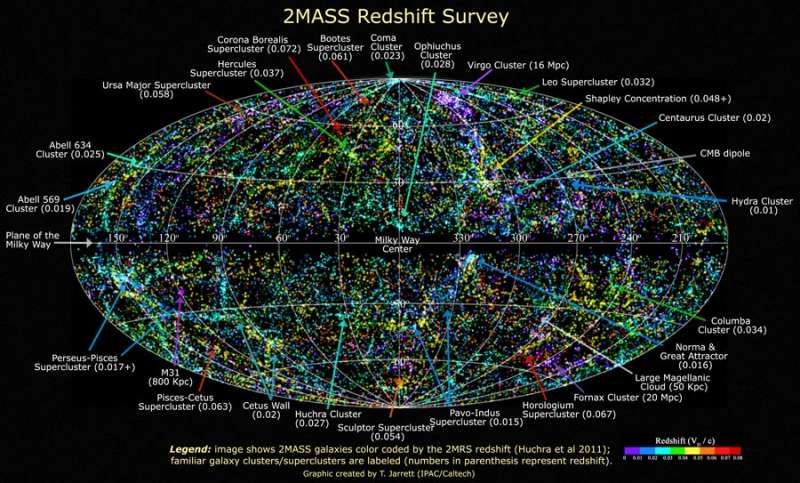
|
Credit & Copyright: 2MASS,
T. H. Jarrett, J. Carpenter, & R. Hurt
Explanation:
What does the universe nearby look like?
This plot shows nearly 50,000 galaxies in the nearby universe detected by the
Two Micron All Sky Survey
(2MASS) in infrared
light.
The resulting image is anincredible tapestry of galaxies that
provides limits on how the universe formed and evolved.
The dark band across
the image center is blocked by dust in the
plane of our own
Milky Way Galaxy.
Away from the Galactic plane, however, each dot represents a
galaxy, color
coded to indicate distance.
Bluer dots represent the nearer galaxies in the
2MASS survey,
while redder dots indicating the more
distant survey galaxies that lie at a
redshift near 0.1.
Named structures are annotated around the edges.
Many galaxies are
gravitationally bound together to form
clusters,
which themselves are loosely bound into
superclusters,
which in turn are sometimes seen to
align over even larger scale structures.
|
January February March April May June July August September October November December |
| ||||||||||||||||||||||||||||||||||||||||||||||||
NASA Web Site Statements, Warnings, and Disclaimers
NASA Official: Jay Norris. Specific rights apply.
A service of: LHEA at NASA / GSFC
& Michigan Tech. U.
Based on Astronomy Picture
Of the Day
Publications with keywords: universe - galaxies - infrared - 2MASS
Publications with words: universe - galaxies - infrared - 2MASS
See also:
- APOD: 2025 November 23 Á The Observable Universe
- APOD: 2025 August 28 Á Galaxies, Stars, and Dust
- APOD: 2025 March 2 Á The Hubble Ultra Deep Field in Light and Sound
- APOD: 2025 February 23 Á Saturn in Infrared from Cassini
- APOD: 2024 December 31 Á The Twisted Disk of NGC 4753
- APOD: 2024 December 18 Á NGC 660: Polar Ring Galaxy
- APOD: 2024 December 1 Á Cosmic Latte: The Average Color of the Universe
